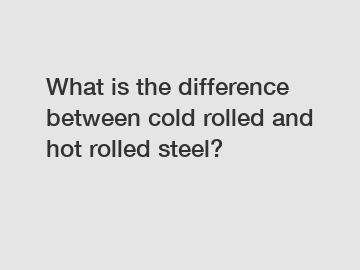What is the difference between cold rolled and hot rolled steel?
What is the difference between cold rolled and hot rolled steel?
Steel is one of the most widely used materials in various industries, from construction to manufacturing. When it comes to steel processing, there are two popular methods: cold rolling and hot rolling. The main difference between these two processes lies in the temperature at which the steel is processed. Cold rolled steel refers to steel that is processed below the recrystallization temperature, while hot rolled steel is processed above the recrystallization temperature.
The recrystallization temperature is the temperature at which new grains of steel form during the process. Cold rolling involves passing the steel through rollers at room temperature, which not only shapes the steel but also improves its mechanical properties. On the other hand, hot rolling involves heating the steel above its recrystallization temperature, typically around 1200 degrees Celsius, before sending it through the rollers.

The key benefit of cold rolling is its ability to produce steel with enhanced surface finish, dimensional accuracy, and greater strength. By processing the steel at room temperature, cold rolling avoids the surface imperfections that can occur during hot rolling. Additionally, the lower temperature during cold rolling allows for tighter control over the thickness and width of the steel, resulting in more precise dimensions. The work hardening that occurs during cold rolling also contributes to the increased strength of the steel.
Hot rolling, on the other hand, is favored for its efficiency and cost-effectiveness. The high temperature of the process allows for quicker shaping of the steel, making it suitable for large-scale production. Hot rolled steel also tends to have a more relaxed stress-strain state, which can be advantageous in certain applications. Moreover, the higher temperature helps to refine the grain structure of the steel, leading to improved toughness and ductility.
The choice between cold rolled and hot rolled steel ultimately depends on the intended application. Cold rolled steel is commonly used in industries such as automotive, aerospace, and appliances, where high precision and surface quality are crucial. Hot rolled steel, with its lower cost and faster production times, is often used in construction, pipelines, and structural components.
In conclusion, the difference between cold rolled and hot rolled steel lies in the temperature at which the steel is processed. Cold rolling produces steel with improved surface finish, dimensional accuracy, and strength, while hot rolling offers efficiency and cost-effectiveness. Understanding these differences allows manufacturers to select the appropriate steel processing method for their specific requirements.
For more information, please visit hot rolled thread bar, thred bar, thread bar for post tensioning manufacturer.


